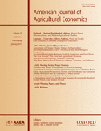Total Factor and Relative Agricultural Productivity and Deforestation
Steven Rose ([email protected]) is Senior Research Economist, Energy and Environmental Analysis Research Group, Electric Power Research Institute. Alla Golub ([email protected]) is Research Economist, Department of Agricultural Economics, Purdue University. Brent Sohngen ([email protected]) is Professor, Department of Agricultural, Environmental, and Development Economics, Ohio State University. Rose is the corresponding author: [email protected]. We would like to thank Tom Hertel for extremely valuable guidance and comments.
This article was presented in an invited paper session at the 2012 AAEA annual meeting in Seattle, WA. The articles in these sessions are not subjected to the journal's standard refereeing process.
Deforestation is a significant global source of greenhouse gas emissions and an historical contributor to climate change. Agricultural production is the primary driver of tropical deforestation, and some have suggested that agricultural productivity improvements should be a part of the strategy for addressing deforestation. Land-use projections that model crop yield improvements support this perspective (e.g. Sands and Leimbach 2003; Baker et al. 2013; Havlík et al. 2013). Recent studies, however, have pointed out the importance of considering total factor productivity (TFP) versus partial factor productivity (PFP) growth, such as in crop yields, where PFP can be misleading (Nin et al. 2003).
Estimates of historical agricultural TFP growth patterns exhibit significant variation across regions and agricultural sectors (Ludena et al. 2007; Fuglie 2010), and some authors have projected potential variation in agricultural TFP growth (Ludena et al. 2007; Hertel, Ludena and Golub 2009). Ludena et al. (2007) and Hertel, Ludena and Golub (2009) also characterize regional and sectoral technological change as having two facets—convergence (or catching up) to the technological frontier, and shifts in the frontier. The combination determines TFP growth, that is, increases in output for a given set of inputs. The historical pattern of convergence and frontier shifts also exhibits significant variation between agricultural sectors and across global regions. Thus, convergence towards or divergence from the frontier is likely a factor in agricultural production and land use, as is the pattern of agricultural productivity growth across regions and sectors.
From a deforestation perspective, this body of literature motivates a number of research questions. For example, what are the deforestation implications of TFP growth? How important is the pattern of productivity growth to global agriculture and deforestation? Can convergence, and TFP growth, help reduce deforestation? To answer these questions, we build future projections based on historical analysis, and use a global dynamic computable general equilibrium model to consider alternative future global agricultural technological change patterns. Using endogenous land allocation and management decisions across heterogeneous land types, and an endogenous total land endowment, we are able to explore consequences for global agricultural production, land allocation and extensification outcomes, including implications for deforestation.
Agriculture Total Factor Productivity
Estimated TFP growth for agriculture from 1961 to 1996 is shown in the left side of figure 1. Significant variation exists across crops and ruminants, as well as across regions. For instance, all regions of the world experienced outward shifts in the agricultural productivity frontier. However, most regions also moved further from the frontier during this time; the exceptions are ruminants in China and crops in industrialized countries. Overall, TFP has increased in most regions and agricultural sectors for a variety of reasons, including public/private investment, reforms, and diffusion. Crop and ruminant TFP has declined or been stagnant in a few regions–South and Southeast Asia and Middle East and North Africa (MENA).
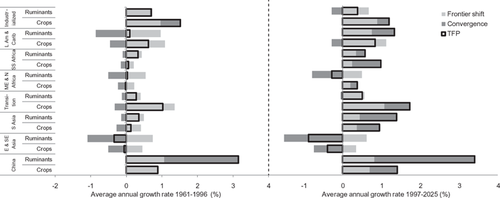
Agricultural productivity growth rates 1961–1996 and 1997–2025 Source: Derived from Hertel, Ludena and Golub (2009).
It is useful to take a moment to distinguish TFP growth from PFP growth. The former refers to increased productivity of all production inputs, while the latter refers only to the improved productivity of a single input, such as land in the case of crop yield improvements. PFP estimates, such as output per hectare or output per head, tend to overestimate productivity growth for crops and livestock, especially for developing countries, because they do not adjust for input substitution that has affected productivity, such as fertilizers or irrigation, and attribute all changes in output to a single input (Nin et al. 2003). Furthermore, many productivity improvements are not pure PFP improvements because they affect the productivity of multiple inputs.
Hertel, Ludena and Golub (2009) projected TFP growth to 2025 using historical technological change and a logistic convergence assumption (figure 1, right). The result was convergence in most regions, which is somewhat of a departure from the historical pattern. Figure 1 represents one potential future pattern of productivity improvement. It exhibits heterogeneity across regions, agricultural sectors, frontier shifts, and convergence.
In this paper, we explore the land use and production implications of productivity patterns by considering alternative TFP patterns derived from the same data. Specifically, we consider the following scenarios: global uniform growth, regional uniform growth, regional/sectoral differentiated growth, and technological frontier shifts only (no convergence). The alternative TFP growth rate assumptions for the regions of our economic model are presented in table 1. The regional/sectoral pattern in table 1 is the TFP growth pattern shown in figure 1 (right). For global uniform growth, we assume uniform weighted average TFP growth for all regions and agricultural sectors. For regional uniform growth, we assume uniform weighted average growth across agricultural sectors within each region, but variation across regions. Weighted averages were derived using output share weights (Hertel, Ludena and Golub 2009), and includes TFP growth in crops, ruminants and non-ruminants, all of which are sectors in our model, though only the first two are land-using. Finally, for the frontier shift pattern, we evaluate the role of convergence by assuming no convergence/divergence (i.e. leaving out the 1997-2025 figure 1 convergence bars). Thus, each region maintains its distance from the technological frontier as the frontier shifts out over time. Below we briefly describe our economic modeling framework before discussing our results.
| ANZ | China | HY Asia | SE Asia | S Asia | N Am | L Am | W EU | EIT | MENA | SSA | World | |
|---|---|---|---|---|---|---|---|---|---|---|---|---|
| Global uniform | ||||||||||||
| All Ag. Sectors | 1.43 | 1.43 | 1.43 | 1.43 | 1.43 | 1.43 | 1.43 | 1.43 | 1.43 | 1.43 | 1.43 | 1.43 |
| Regional uniform | ||||||||||||
| All Ag. Sectors | 0.86 | 3.07 | 0.86 | 0.11 | 1.13 | 0.86 | 1.53 | 0.86 | 1.48 | 0.17 | 0.86 | 1.43 |
| Regional/sectoral | ||||||||||||
| Crops | 1.21 | 1.41 | −0.39 | −0.39 | 0.95 | 1.21 | 0.83 | 1.21 | 1.75 | 0.38 | 0.99 | 1.02 |
| Ruminants | 0.39 | 3.42 | 0.39 | −0.90 | 1.40 | 0.39 | 1.35 | 0.39 | 0.51 | −0.29 | 0.58 | 1.22 |
| Frontier shift only (no convergence) | ||||||||||||
| Crops | 0.89 | 0.70 | 0.35 | 0.35 | 0.37 | 0.89 | 1.12 | 0.89 | 1.08 | 0.20 | 0.25 | 0.69 |
| Ruminants | 0.67 | 0.82 | 0.67 | 0.62 | 0.44 | 0.67 | 0.76 | 0.67 | 0.56 | 0.50 | 0.35 | 0.64 |
- a Note: ANZ=Australia/New Zealand; HY Asia=high income Asia;, SE Asia=Southeast Asia; S Asia=South Asia; N Am=North America; L Am=Latin America; W EU=Western EU; EIT=Economies in transition; MENA=Middle East/North Africa; SSA=Sub-Saharan Africa.
Model
We use a modified version of the dynamic computable general equilibrium (CGE) model documented in Golub, Hertel and Sohngen (2009). The description here offers only a brief characterization of the model's features.
The model incorporates an econometrically estimated, international cross-section, implicit directly additive demand system (AIDADS), which captures consumption bundle changes with rising incomes–a particularly important dynamic in fast-growing developing countries with changing food consumption preferences.
The supply side of the model is constructed from the standard GTAP model's constant returns to scale, nested constant elasticity of substitution production functions. In forestry, the substitution between land and other value added inputs is incorporated to reflect changes in output per unit of land with respect to changes in management intensity, as estimated by the Global Timber Model of Sohngen and Mendelsohn (2006). In food processing, the substitution between farm-based products and marketing inputs is introduced, thus providing a form of possible intensification that reduces the pressure of growing consumer demands on land.
Consumer demand is translated into the derived demands for land through sectoral production functions. Equilibrium land rents are determined by equating these demands to land supply. Land endowment in each region is disaggregated into Agro-Ecological Zones (AEZs), which represent heterogeneity in biophysical productivity of land where AEZs labeled with higher numbers indicate greater productivity. Within each AEZ, the mobility of land across uses is modeled as a nested constant elasticity of transformation function–the elasticity of which captures the ease/cost of conversion.
Technological change in the agricultural sectors varies by scenario, as described in the previous section. Forestry input-augmenting technical change in the forestry processing sectors is based on the Global Timber Model (Sohngen and Mendelsohn 2006). Unlike many CGE models, our land endowment is endogenous and can expand into extensive tropical forests. Thus, total managed land—cropland, pasture, and intensive forest—can expand or contract within each tropical region and AEZ. Land endowment expansion within each AEZ is controlled by a land endowment elasticity parameter. Specifically, the elasticity is the percentage change in land endowment relative to the percentage change in land rents. This approach is different from that initially used in Golub, Hertel and Sohngen (2009). The elasticities were estimated with the Global Timber Model and alternative agricultural commodity demand scenarios. The endowment elasticities provide a measure of responsiveness on how readily extensive tropical forest lands are converted into commercial use when returns to land increase. Extensive tropical forests are not economical to access given current market conditions; for them to become so, agricultural and/or timber prices would need to rise, and/or costs fall (production or access). When accessed, the additional endowment can be utilized by any of the managed land use activities in the CGE model to produce crops, livestock, or timber.
Results
Because of our interest in deforestation, we begin our results discussion with tropical land use. We then broaden our discussion to consider relative agricultural productivity and convergence implications globally for agricultural production and land use, including temperate deforestation.
Tropical land use
We evaluate the implications of the agricultural productivity patterns on the extent of managed land, that is, land endowment expansion into extensive forests in Southeast Asia, Latin America, and Sub-Saharan Africa, as well as on managed land use within the land endowment.
Our first observation is that land endowment expansion in all three tropical regions is responsive to the global TFP growth pattern (figure 2, first panel). Southeast Asia and Latin America are more responsive to the alternative TFP patterns, while Sub-Saharan Africa is less responsive. Note that the land change results in figure 2 and subsequent figures are revenue share-weighted percentage changes. We present percentage changes because of our interest in relative responses to alternative productivity growth patterns, and revenue share-weighted changes are a useful metric for capturing commercially valuable land changes.
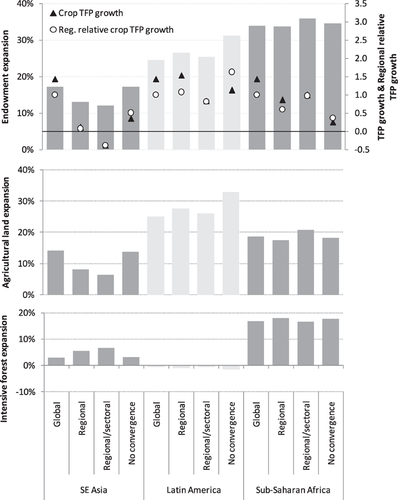
Tropical endowment expansion and land use change by 2025, and annual crop TFP growth (absolute and relative), by TFP growth pattern
In Southeast Asia and Sub-Saharan Africa, endowment expansion is driven by a combination of agricultural and intensive forestry land expansion, where intensive forests are both managed and plantation forests (figure 2, second and third panels). However, in Latin America, agricultural land expansion contributes to both intensive, as well as extensive, forest loss. In all three regions, across productivity scenarios we see trade-offs between agriculture and intensive forest land. For instance, in Southeast Asia, the global uniform pattern produces higher agricultural land expansion than the other patterns, and lower intensive forest expansion. While in Latin America, the global uniform pattern produces lower agricultural land expansion and less intensive forest loss. Thus, agricultural land expansion results in intensive and extensive forest loss in the form of reduced forest expansion or increased forest loss. Across scenarios, cropland changes are the key driver of net agricultural land use change; however, pasture acreage is also changing.
In figure 2, we also plot crop TFP growth (triangles), and find that they are likely a part of the explanation for the endowment expansion variation in Southeast Asia across productivity scenarios, and possibly Latin America. Higher regional crop TFP growth in these regions is consistent with land endowment expansion. However, a few observations make it clear that there is more to it. First, we see a non-proportional relationship between crop TFP growth and endowment expansion. For instance, Southeast Asia crop TFP declines 93% between the global and regional uniform scenarios, yet there is only a 25% decrease in endowment expansion. Second, the relationship is not unique within a region (e.g., an 18% cumulative endowment expansion in Southeast Asia corresponds with annual TFP growth rates of 1.43% and 0.35%). Finally, there are different crop TFP-endowment expansion relationships across regions. Overall, we only find a strong positive correlation in Southeast Asia (correlation coefficient 0.81), and weak negative correlations in the other two tropical regions. Thus, TFP growth can drive deforestation, but other factors are also relevant.
Another possible factor is relative regional crop TFP growth (figure 2 dots). Regional TFP growth relative to the world average (last column, table 1). In Southeast Asia and Latin America, we find correlations with endowment expansion of 0.93 and 0.94, respectively. For Sub-Saharan Africa, there is a positive but weak correlation of 0.32. Thus, we find that increased deforestation at the extensive frontier corresponds with increased relative agricultural productivity in both Southeast Asia and Latin America, and increased agricultural productivity on its own in Southeast Asia. Given this evidence, we explore relative productivity growth more thoroughly below, including the implications for temperate forests and land use.
Relative Productivity
The land use change outcomes are the result of many drivers, including population, income, regional differences in resources and markets, and technological improvements in general. To isolate the effects of relative agricultural productivity we want to control for the effects of other drivers. We can accomplish this by normalizing to the global uniform TFP growth results. With no differences in relative productivity growth, the results from the global uniform scenario represent the implications of all drivers except differences in relative agricultural productivity. Normalized results will allow us to focus on the responsiveness of regions and sectors to changes in the agricultural productivity patterns in the form of deviations from the global uniform TFP growth results. We explore how relative productivity affects the future by looking at the implications for year 2025 outcomes. Also, because we are interested in responsiveness to relative productivity changes, the implications are presented in percentage terms. We focus our discussion on the implication of region and region/sector TFP growth heterogeneity, and discuss convergence separately afterwards.
The regional productivity pattern deviations from the global uniform pattern exhibit decreases in agricultural TFP in 2025 for all but three regions. See figure 3 (top) for illustrative results for a few regions. We find that higher agricultural TFP growth corresponds with increased agricultural output and decreased forestry output. Agricultural production increases benefit consumers with increased supply and lower prices. Behind the agricultural production responses are increases in returns to agricultural land and increases in agricultural land area that converts both intensive and extensive forests. In all three regions with increased TFP growth we find increasing cropland, but in China it is at the expense of pasture, as well as forests, while in Latin America and countries with transition economies, pasture acreage is also increasing. For regions with lower TFP (e.g. Southeast Asia and North America), we find reductions in output, land endowment, and cropland (with increasing intensive forest and pasture area).
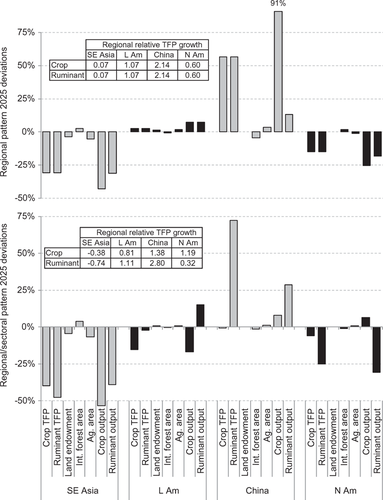
2025 deviations (%) from global uniform TFP pattern levels for selected regions (Regional TFP deviations top, Regional/sectoral deviations bottom)
Note that the output responses (positive and negative) are frequently greater than the TFP changes. This is caused by changes in regional competitiveness due to differences in relative TFP growth (table in figure 3). For instance, crop TFP increases almost 60% in China, but crop production increases 90%, as China's TFP growth is twice the global average. Note also that the land use change responses are much smaller than the TFP and output changes. This is due in part to the fact that TFP changes impact existing and new agricultural lands, and demand-side market mediation of production changes. Finally, for understanding the role of crop TFP, it is helpful to note the relative preference for crop production. Despite identical TFP growth across crops and ruminants in the regional uniform growth scenario, percentage changes in crop land rents and output are more than they are for pasture/ruminants (e.g. China), as crops are viewed as a higher value land use, producing both food and livestock feed.
Figure 3 (bottom) also presents illustrative regional deviations associated with the region/sector TFP growth pattern. There is significant relative TFP growth heterogeneity within and across sectors. Land use and output now respond to three forces: TFP growth itself, relative TFP growth across regions, and relative TFP growth across sectors. In Southeast Asia, we have declining TFP and lower crop and ruminant TFP than the global averages, which together result in lower output, land endowment, and agricultural land area. In Latin America, there is also lower crop and ruminant TFP growth, but relative ruminant TFP growth is strong and results in increased ruminant output, and increased agricultural acreage and land endowment. The role of relative TFP growth across sectors (vs. regions) is also evident in China, where relative TFP growth is strong in both crops and ruminants. However, growth is significantly stronger in ruminants and, as a result, so is the increase in ruminant output. North America is another example where stronger relative crop TFP growth translates into increased crop production despite lower absolute TFP. In both China and North America we find deforestation of intensive forests with pasture and cropland expansion, respectively.
Plotting all the deviations across scenarios and regions within each scenario (including no convergence deviations), we find strong positive correlations between output and relative TFP growth for both crop and ruminant production (figure 4), with the relationship for crop production being stronger. A similar type of figure for revenue share-weighted accessible forest area change and relative regional crop TFP reveals a robust negative correlation (figure 5). Thus, while increased TFP can increase deforestation of intensive and extensive forests, increased relative TFP has an even stronger relationship with deforestation. Figure 5 shows that the slope of the relationship varies by AEZ, but the negative correlation is robust across AEZs.
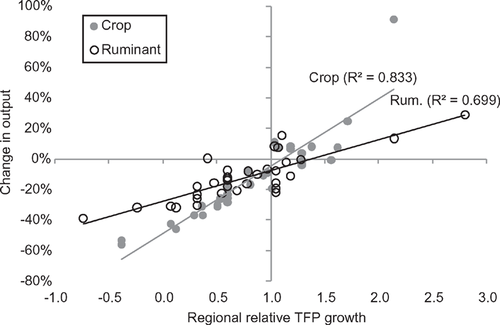
2025 deviations in regional crop and ruminant output with respect to relative regional TFP growth
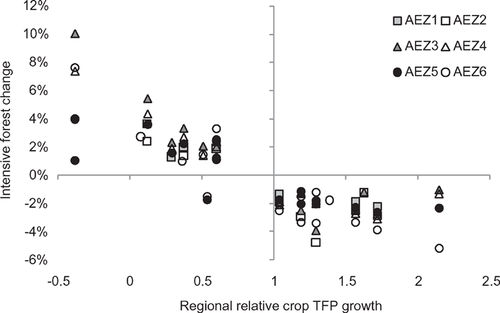
2025 deviations in regional intensive forest land (revenue share weighted) with respect to relative regional TFP growth
Productivity Convergence
We now provide a brief discussion of the role of convergence. Convergence is especially important for developing and transitional economies, but we find that developing/transitional region convergence is also important to developed regions because of its relative effects. Convergence is a large fraction of the projected TFP growth from Hertel et al. (2009). However, convergence processes are not well understood, and other future patterns are certainly feasible (e.g. recall the left vs. right hand sides of figure 1). We explore the importance of convergence by simply removing the convergence/divergence assumptions and comparing the results to the region/sector TFP growth pattern. We find that in this formulation, convergence (both absolute and relative) operates like changes in net TFP growth. For instance, tropical agricultural productivity convergence improves relative regional productivity, which increases regional output and deforestation, while reducing developed country production.
Conclusion
Agriculture is a primary driver of global deforestation, and agricultural productivity is a critical factor that some suggest could be stimulated to diminish land competition and reduce deforestation. Total factor productivity improvements have been an important part of historic agricultural productivity gains. Agricultural TFP growth can vary by region and agricultural commodity, as well as in the composition of growth between convergence and shifts in the technological frontier. This paper analyzes the potential implications of TFP growth and productivity growth patterns for deforestation, as well as overall land use and agricultural production.
We find that agricultural TFP growth patterns can be very important to global agriculture and deforestation. In particular, we find that relative regional total factor productivity increases, including technological convergence (or catching-up), could increase regional deforestation. Agricultural total factor productivity improvements, especially for crops, imply increased returns to agricultural lands and increased incentives for regional deforestation of extensive and intensive forests. However, this outcome is not inevitable, as relative productivity growth across regions and commodity sectors significantly influences land use decisions. The importance of relative TFP growth is evident in the changes in global land rents and agricultural output, and ultimately in agricultural land expansion. Overall, we found strong positive correlations, especially for crops, between relative regional agricultural TFP growth and both output and deforestation.
Our results have potential implications for targeted productivity improvements to regions/sectors, which is something of policy interest as a development strategy or strategy for reducing deforestation. Our findings suggest that increases in relative regional TFP could lead to significant regional gains in output with consumer welfare and GDP benefits, as well as potential regional deforestation implications. We directly confirmed this insight via supplemental scenarios that increased TFP growth in individual tropical regions and agricultural sectors off of the region/sector TFP scenario (Latin America/Southeast Asia, crops/ruminants). We found that regional improvements in crop TFP, ceteris paribus, led to increased regional extensive and intensive forest loss and pastureland conversion to cropland. However, improvements in regional ruminant TFP, ceteris paribus, produced virtually no change in land endowment, but did result in modest managed land reallocation towards pastureland. These results suggest that regional sector-specific TFP improvements may not be a promising means for reducing deforestation.
Note that this paper was not intended to promote or validate particular productivity growth assumptions. Instead, we illustrate the importance of relative productivity improvements and technological diffusion that affects both production opportunities via frontier shifts and realized improvements associated with keeping up or converging towards the shifting frontier. We also highlight the importance of TFP, and of understanding what kind of agricultural productivity growth is implied by different technological improvements. We hope this study motivates further dialogue on productivity projection assumptions, as well as research into a better understanding of historic agricultural productivity and improvement mechanisms for regional convergence and technological frontier shifts.



